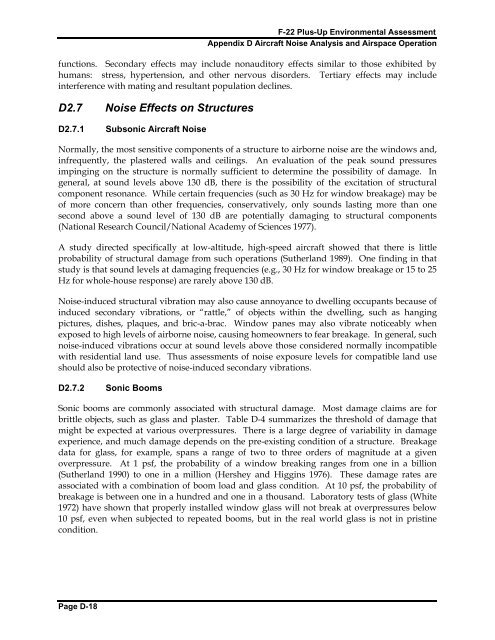F-22 Plus-Up Environmental Assessment - Joint Base Elmendorf ...
F-22 Plus-Up Environmental Assessment - Joint Base Elmendorf ...
F-22 Plus-Up Environmental Assessment - Joint Base Elmendorf ...
You also want an ePaper? Increase the reach of your titles
YUMPU automatically turns print PDFs into web optimized ePapers that Google loves.
F-<strong>22</strong> <strong>Plus</strong>-<strong>Up</strong> <strong>Environmental</strong> <strong>Assessment</strong><br />
Appendix D Aircraft Noise Analysis and Airspace Operation<br />
functions. Secondary effects may include nonauditory effects similar to those exhibited by<br />
humans: stress, hypertension, and other nervous disorders. Tertiary effects may include<br />
interference with mating and resultant population declines.<br />
D2.7 Noise Effects on Structures<br />
D2.7.1<br />
Subsonic Aircraft Noise<br />
Normally, the most sensitive components of a structure to airborne noise are the windows and,<br />
infrequently, the plastered walls and ceilings. An evaluation of the peak sound pressures<br />
impinging on the structure is normally sufficient to determine the possibility of damage. In<br />
general, at sound levels above 130 dB, there is the possibility of the excitation of structural<br />
component resonance. While certain frequencies (such as 30 Hz for window breakage) may be<br />
of more concern than other frequencies, conservatively, only sounds lasting more than one<br />
second above a sound level of 130 dB are potentially damaging to structural components<br />
(National Research Council/National Academy of Sciences 1977).<br />
A study directed specifically at low-altitude, high-speed aircraft showed that there is little<br />
probability of structural damage from such operations (Sutherland 1989). One finding in that<br />
study is that sound levels at damaging frequencies (e.g., 30 Hz for window breakage or 15 to 25<br />
Hz for whole-house response) are rarely above 130 dB.<br />
Noise-induced structural vibration may also cause annoyance to dwelling occupants because of<br />
induced secondary vibrations, or “rattle,” of objects within the dwelling, such as hanging<br />
pictures, dishes, plaques, and bric-a-brac. Window panes may also vibrate noticeably when<br />
exposed to high levels of airborne noise, causing homeowners to fear breakage. In general, such<br />
noise-induced vibrations occur at sound levels above those considered normally incompatible<br />
with residential land use. Thus assessments of noise exposure levels for compatible land use<br />
should also be protective of noise-induced secondary vibrations.<br />
D2.7.2<br />
Sonic Booms<br />
Sonic booms are commonly associated with structural damage. Most damage claims are for<br />
brittle objects, such as glass and plaster. Table D-4 summarizes the threshold of damage that<br />
might be expected at various overpressures. There is a large degree of variability in damage<br />
experience, and much damage depends on the pre-existing condition of a structure. Breakage<br />
data for glass, for example, spans a range of two to three orders of magnitude at a given<br />
overpressure. At 1 psf, the probability of a window breaking ranges from one in a billion<br />
(Sutherland 1990) to one in a million (Hershey and Higgins 1976). These damage rates are<br />
associated with a combination of boom load and glass condition. At 10 psf, the probability of<br />
breakage is between one in a hundred and one in a thousand. Laboratory tests of glass (White<br />
1972) have shown that properly installed window glass will not break at overpressures below<br />
10 psf, even when subjected to repeated booms, but in the real world glass is not in pristine<br />
condition.<br />
Page D-18
















